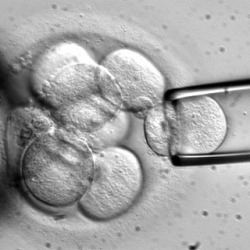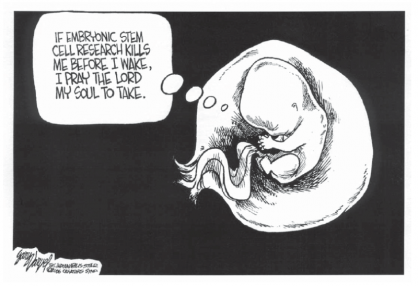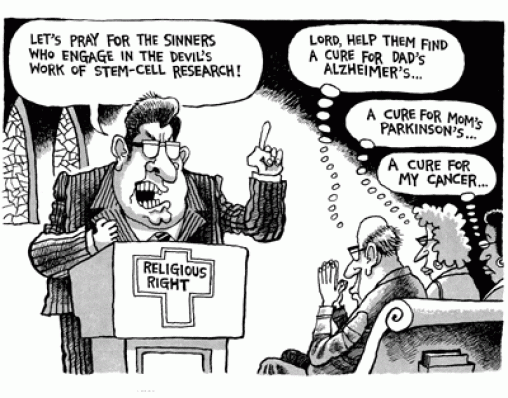Stem Cell Research
The Profit of Science - What is Stem Cell Research?

In the world that we live in today, science and technology are progressing at a remarkably rapid rate. We have broken the barriers of what we call space, we have split the atom, created alternate energy sources, we are finding ways to better our planet, and our technology and our discoveries will only become augmented in the future.
Stem Cell research has been a phenomenal breakthrough in the field of medical research and biotechnology. Stem cells are crucial to develop vital organs. Stem cells are non-specialized cells that have the potential to develop into other specific types of cells such as brain, blood, muscle, or nerve cells. Stem cells are found in almost all parts of the body but are most potent within a fetus rather an adult. The topic of Stem cell research has lead up to an intense debate about ethics. Only until recent years, the method of research mainly focused on Embryonic Stem cells, which involved taking the tissue of an aborted embryo to obtain proper study material. Stem cell research has many benefits and can potentially aid in treating or maybe even curing a range of medical dieses that were known not to be curable. It could possibly lead the entire human race closer to wiping out a number of diseases such as Parkinson’s, Alzheimer’s, Diabetes, Birth Defects, Stem cells may repair or replace damaged organ, and it may play a major role in cancer. The treatment of these diseases could also give significant social benefits for individuals and economic gains for the society.
Stem cells are found in all complex eukaryotic organisms. They are non-specialized cells and have the potential to become different types of cells such as cardiac tissues or nerve cells. They are also regenerative and undergo a process called self-renewal, a series of mitotic divisions, which multiplies to create more stem cells. Stem cells are used to replace damaged or missing cells, replicated through mitotic divisions and “fill in” the tissues that it is specialized for. Stem cells have four different types of potency. When a zygote is first formed from the fertilization of a sperm cell and egg cell, it is said to be totipotent, meaning that is has the ability to morph into embryonic tissues as well as extraembryonic tissues (such as the yolk or amnion sac in an egg or the placenta in human females). The totipotent zygote undergoes mitosis and forms a blastocyst, an early embryonic stage. Inside the blastocyst are the pluripotent stem cells, the cells that are commonly used for stem cell research. Pluripotent stem cells are able to change and specialize into any cells derived from any of the three germ layers (ectoderm, endoderm, and mesoderm); basically our entire body is made of these three germ layers, which is made up of more than 200 different unipotent stem cells. Multipotent stem cells are able to give rise to cells that are closely related and erythrocytes (red blood cells), leukocytes (white blood cells), and platelets.
Stem Cell research has been a phenomenal breakthrough in the field of medical research and biotechnology. Stem cells are crucial to develop vital organs. Stem cells are non-specialized cells that have the potential to develop into other specific types of cells such as brain, blood, muscle, or nerve cells. Stem cells are found in almost all parts of the body but are most potent within a fetus rather an adult. The topic of Stem cell research has lead up to an intense debate about ethics. Only until recent years, the method of research mainly focused on Embryonic Stem cells, which involved taking the tissue of an aborted embryo to obtain proper study material. Stem cell research has many benefits and can potentially aid in treating or maybe even curing a range of medical dieses that were known not to be curable. It could possibly lead the entire human race closer to wiping out a number of diseases such as Parkinson’s, Alzheimer’s, Diabetes, Birth Defects, Stem cells may repair or replace damaged organ, and it may play a major role in cancer. The treatment of these diseases could also give significant social benefits for individuals and economic gains for the society.
Stem cells are found in all complex eukaryotic organisms. They are non-specialized cells and have the potential to become different types of cells such as cardiac tissues or nerve cells. They are also regenerative and undergo a process called self-renewal, a series of mitotic divisions, which multiplies to create more stem cells. Stem cells are used to replace damaged or missing cells, replicated through mitotic divisions and “fill in” the tissues that it is specialized for. Stem cells have four different types of potency. When a zygote is first formed from the fertilization of a sperm cell and egg cell, it is said to be totipotent, meaning that is has the ability to morph into embryonic tissues as well as extraembryonic tissues (such as the yolk or amnion sac in an egg or the placenta in human females). The totipotent zygote undergoes mitosis and forms a blastocyst, an early embryonic stage. Inside the blastocyst are the pluripotent stem cells, the cells that are commonly used for stem cell research. Pluripotent stem cells are able to change and specialize into any cells derived from any of the three germ layers (ectoderm, endoderm, and mesoderm); basically our entire body is made of these three germ layers, which is made up of more than 200 different unipotent stem cells. Multipotent stem cells are able to give rise to cells that are closely related and erythrocytes (red blood cells), leukocytes (white blood cells), and platelets.
The Great Debate: Stem Cell Research

Many shiver at the thought of scientists probing at an early formed embryo, which could have grown and matured into a child with life. Many also ponder that the thought of when scientists would draw the line between helping the masses with the illnesses and playing the role of god, which should not be tampered with. Stem cell research has a slick cross between genetic engineering and reproductive cloning from fetal harvesting. The controversy over stem cell research has brought in so many degrees to is rhetoric, ranging from social and religious to political and ethical arguments.
Many believe that stem cell research removes the value of life. Since stem cell research requires embryonic cells, scientists were required to engage the fruitful process of fetal harvesting, fertilizing eggs with sperm within a controlled environment such as a lab. Some debate that process is equivalent to cloning an takes away the value of life and also that the embryos could have grown and matured to have a life. Others in the scientific and medical field debate that results of al the stem cell research will outweigh the sacrifice of a few embryos. Using 10,000 embryo’s in research could later result in saving a million people’s lives. In addition to the controversy in embryonic stem cells, there is a have. As the results, they have brought up the idea of using genetic engineering to create a totipotent or pluripotent stem cell. This is a risky idea to the populations because society believes that scientists will not limit themselves, but will push towards cloning and genetic engineering human progeny. Recently however, the use of fetal farming was banned, but many are still debating the use of stem cells for therapeutic cloning or the banning of stem cell research altogether.
Many believe that stem cell research removes the value of life. Since stem cell research requires embryonic cells, scientists were required to engage the fruitful process of fetal harvesting, fertilizing eggs with sperm within a controlled environment such as a lab. Some debate that process is equivalent to cloning an takes away the value of life and also that the embryos could have grown and matured to have a life. Others in the scientific and medical field debate that results of al the stem cell research will outweigh the sacrifice of a few embryos. Using 10,000 embryo’s in research could later result in saving a million people’s lives. In addition to the controversy in embryonic stem cells, there is a have. As the results, they have brought up the idea of using genetic engineering to create a totipotent or pluripotent stem cell. This is a risky idea to the populations because society believes that scientists will not limit themselves, but will push towards cloning and genetic engineering human progeny. Recently however, the use of fetal farming was banned, but many are still debating the use of stem cells for therapeutic cloning or the banning of stem cell research altogether.

